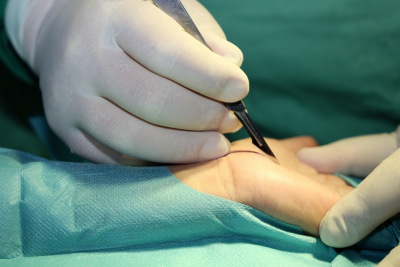Carpal tunnel syndrome refers to pain, tingling, or numbness in one or both hands resulting from compression of the median nerve at the wrist. These symptoms are frequently worse at night, and often improve by shaking of the hand. This problem is diagnosed by a combination of clinical assessment and nerve conduction studies. In some cases, such as during pregnancy, carpal tunnel syndrome may resolve on its own. However in many patients, the problem requires surgery.
Carpal tunnel syndrome frequently responds to analgesia, the use of a hand splint at night, and the avoidance of aggravating activities, such as the operation of vibrating objects (e.g jackhammers). In cases which do not respond to conservative measures, surgery may be indicated. This operation is performed frequently by neurosurgeons, and is known as a carpal tunnel decompression. It involves making a small incision, or cut, in the palm of the hand, and dividing the band of tissue which is constricting the nerve. This is done usually under local anaesthetic and light sedation and the patient returns home on the same day.
Once the anaesthetic has worked, your surgery can take place. The skin is cleaned with antiseptic fluid painted on the skin and sterile towels are used to cover the area. Some surgeons will use a tourniquet to prevent blood from entering the arm. You will be aware of a tight bandage on your upper arm, which is similar to the cuff used when you have your blood pressure taken. On average the operation takes approximately 10 minutes and it is not usually painful. You may be aware of tugging and pulling sensations around your wrist but this will not hurt.
COMPLICATIONS
Complications are uncommon and usually minor.
•Scar tenderness - this is the most commonly experienced problem. It is a nuisance and usually resolves completely. Massaging the scar with a moisturiser helps to settle this.
•Wound infection - seen in up to 1% of cases
•finger stiffness - uncommon and best avoided by keeping the fingers moving
•median nerve injury has been described but this is very rare
REFERENCES
http://www.acsneuro.com/surgeries/peripheral_nerves_detail/carpal_tunnel_decompression
https://www.drugs.com/cg/open-carpal-tunnel-decompression-inpatient-care.html
http://www.yourhands.co.uk/hand-wrist-surgery/operations/carpal-tunnel-decompression

